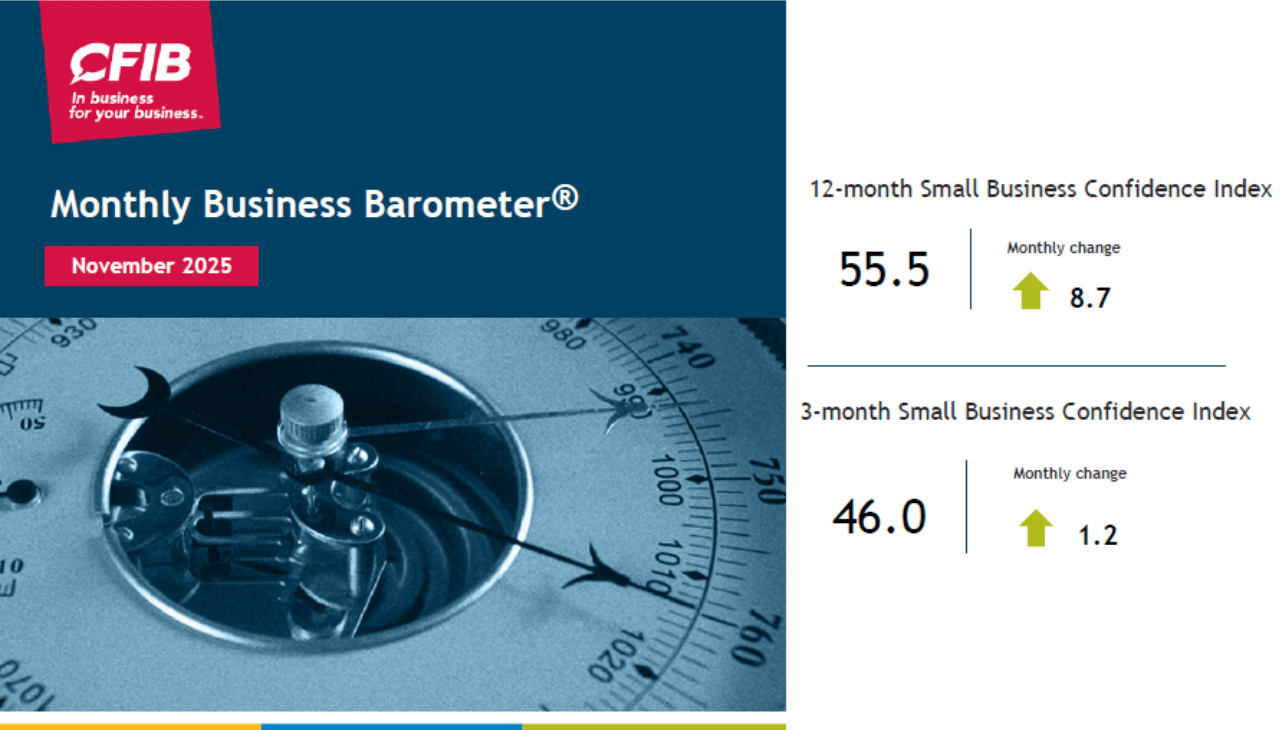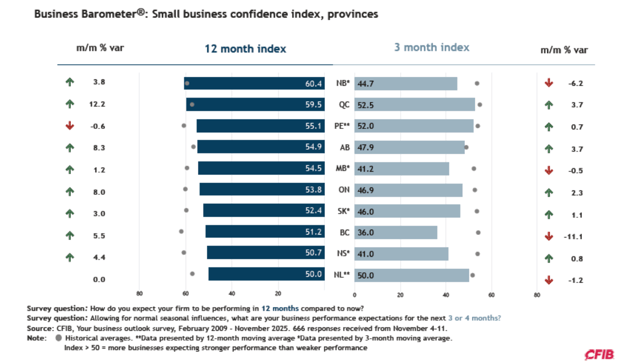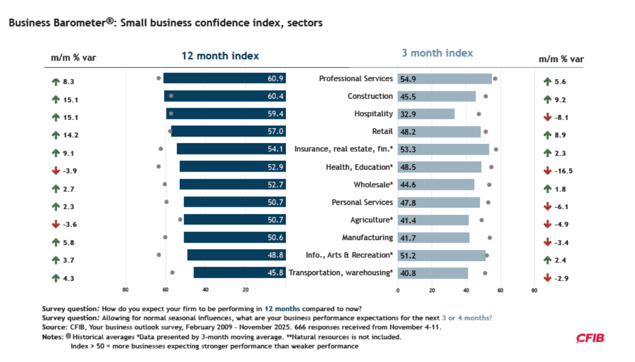
November 2025 Results
Key takeaways
- Small business optimism recovered somewhat in November, reaching a mid-50 level.
- Challenges and uncertainty dominate small business sentiment in 2025, while positive outlooks are less common.
- Average price increase planned for the next 12 months edged down to 2.5.
- Confidence for the next 12 months among retailers jumped 14 points, reaching 57.0, which represents the best reading seen throughout the year but still shy of its historical average (57.8)
Small business optimism in Canada
CFIB’s Business Barometer® long-term index, which is based on 12-month forward expectations for business performance, climbed to 55.5—an increase of 8.7 points from October. The short-term optimism index, based on a 3-month outlook, inched up by 1.2 point to 46.0
Provincial picture
The long-term confidence has regained some momentum in all provinces, except Newfoundland and Labrador, and Prince Edward Island, which remained almost unchanged. All provinces are now on or above the 50-point threshold – the level where equal shares of entrepreneurs expect stronger and weaker performances.

Sectoral overview
Long-term confidence has also improved across most sectors, except for health and education and agriculture. The only sectors remaining below the 50-point mark are information, arts and recreation, and transportation and warehousing services.

For more information about retail sector's expectations, staffing and price plans, visit our new dashboard.
State of business health
Business sentiment about 2025 overall is mixed but tilts negative. Many described the year about to end as challenging, uncertain, or difficult, while a smaller share reported steady or average conditions. Positive outlooks are present but less common, pointing to a generally cautious and uncertain environment.
The current state of business health continues to be below its historical average. Since August 2024, this indicator has been at or above its historical average only four times.
Inflation indicators
The average price increase planned for the next 12 months decreased slightly to 2.5% in November, while the average wage increase remained steady at 2.2%.
Other indicators
Full-time staffing plans show a fragile labour market, with more employers looking to reduce staff (16%) than hiring (12%).
Insufficient demand persists as the primary barrier to business and production expansion (as reported by 56% of SMEs). Key cost constraints hindering business growth include tax and regulatory expenses (72%), insurance costs (69%), and wage costs (61%).
Methodology
These results are based on 666 responses received from November 4 to 11 from a stratified random sample of CFIB members to a controlled-access web survey. Findings are statistically accurate to +/- 3.8 per cent 19 times in 20. Every new month, the entire series of indicators is recalculated for the previous month to include all survey responses received in that previous month. Measured on a scale between 0 and 100, an index above 50 means owners expecting their business’s performance to be stronger over the next three or 12 months outnumber those expecting weaker performance.
The next Business Barometer will be released on December 18, 2025.
For more information about the retail sector, see the dashboard below. It presents long and short term optimism, current state of business health, staffing plans, price and wage plans, as well as main costs and limitations for retail firms.
For regional information about business optimism, price plans, limitations and main cost constraints for SMEs, please visit: the Business Barometer, 2024 Retrospective. We will release the 2025 Retrospective in the second half of December.
Related Documents
| Release Date | Report | Download |
|---|---|---|
| November 2025 | Business Barometer® National Summary |
PDF (2.6 MB) |
| November 2025 | Business Barometer® Provincial Summaries |
PDF (1.3 MB) |
| November 2025 | Business Barometer® Industry Summaries |
PDF (1.4 MB) |
| November 2025 | Business Barometer® Data Table (updated at 8.15EST) |
Excel (600 KB) |
| January 2024 | Current Survey |
PDF (603 KB) |
| April 2020 | Survey - before 2024 |
PDF (84 KB) |




 Share Article
Share Article
 Print Article
Print Article
